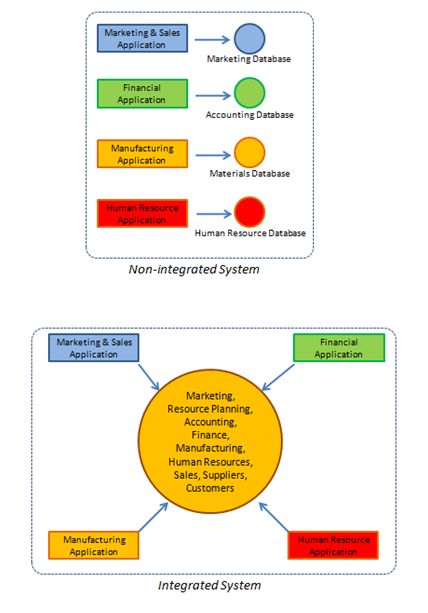Theoretical Paper
- Computer Organization
- Data Structure
- Digital Electronics
- Object Oriented Programming
- Discrete Mathematics
- Graph Theory
- Operating Systems
- Software Engineering
- Computer Graphics
- Database Management System
- Operation Research
- Computer Networking
- Image Processing
- Internet Technologies
- Micro Processor
- E-Commerce & ERP
Practical Paper
Industrial Training
Enterprise Resource Planning
Introduction
In any industry, some of the demands managers face is to be cost effective. In addition to that, they are also faced with challenges such as to analyze costs and profits on a product or consumer basis, to be flexible to face ever altering business requirements, and to be informed of management decision making processes and changes in ways of doing business.
However, some of the challenges holding managers back include the difficulty in attaining accurate information, lack of applications that mimic existing business practices and bad interfaces. When some challengers are holding a manager back, that is where Enterprise Resource Planning (ERP) comes into play.
Over the years business applications have evolved from Management Information Systems with no decision support to Corporate Information Systems, which offer some decision support to Enterprise Resource Planning. Enterprise Resource Planning is a software solution that tackles the needs of an organization, taking into account the process view to meet an organization's goals while incorporating all the functions of an organization.
Its purpose is to make easy the information flow between all business functions within the boundaries of the organization and manage the organization's connections with its outside stakeholders.
In a nutshell, the Enterprise Resource Planning software tries to integrate all the different departments and functions of an organization into a single computer system to serve the various needs of these departments.
The task at hand, of implementing one software program that looks after the needs of the Finance Department together with the needs of the Human Resource Department and the Warehouse, seems impossible. These different departments usually have an individual software program that is optimized in the way each department works.
However, if installed correctly this integrated approach can be very cost effective for an organization. With an integrated solution, different departments can easily share information and communicate with one another.
The following diagram illustrates the differences between non-integrated systems versus an integrated system for enterprise resource planning.

The Driving Force behind ERP
There are two main driving forces behind Enterprise Resource Planning for a business organization.
In a business sense, Enterprise Resource Planning ensures customer satisfaction, as it leads to business development that is development of new areas, new products and new services.
Also, it allows businesses to face competition for implementing Enterprise Resource Planning, and it ensures efficient processes that push the company into top gear.
In an IT sense: Most softwares does not meet business needs wholly and the legacy systems today are hard to maintain. In addition, outdated hardware and software is hard to maintain.
Hence, for the above reasons, Enterprise Resource Planning is necessary for management in today's business world. ERP is single software, which tackles problems such as material shortages, customer service, finances management, quality issues and inventory problems. An ERP system can be the dashboard of the modern era managers.
Implementing ERP System
Producing Enterprise Resource Planning (ERP) software is complex and also has many significant implications for staff work practice. Implementing the software is a difficult task too and one that 'in-house' IT specialists cannot handle. Hence to implement ERP software, organizations hire third party consulting companies or an ERP vendor.
This is the most cost effective way. The time taken to implement an ERP system depends on the size of the business, the number of departments involved, the degree of customization involved, the magnitude of the change and the cooperation of customers to the project.
Advantages of ERP System
With Enterprise Resource Planning (ERP) software, accurate forecasting can be done. When accurate forecasting inventory levels are kept at maximum efficiency, this allows for the organization to be profitable.
Integration of the various departments ensures communication, productivity and efficiency.
Adopting ERP software eradicates the problem of coordinating changes between many systems.
ERP software provides a top-down view of an organization, so information is available to make decisions at anytime, anywhere.
Disadvantages of ERP System
Adopting ERP systems can be expensive.
The lack of boundaries created by ERP software in a company can cause problems of who takes the blame, lines of responsibility and employee morale.
Conclusion
While employing an ERP system may be expensive, it offers organizations a cost efficient system in the long run.
ERP software works by integrating all the different departments in on organization into one computer system allowing for efficient communication between these departments and hence enhances productivity.
The organizations should take extra precautions when it comes to choosing the correct ERP system for them. There have been many cases that organizations have lost a lot of money due to selecting the 'wrong' ERP solution and a service provider for them.

